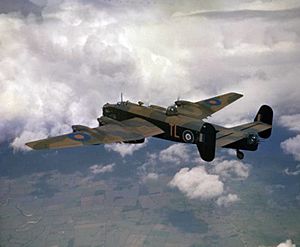No. 1586 (Polish Special Duties) Flight facts for kids
Quick facts for kids No. 1586 Flight RAF |
|
|---|---|

A Halifax similar to those flown by 1586 Flt.
|
|
| Active | 4 November 1943 – 7 November 1944 |
| Allegiance | |
| Role | Special Duties |
| Garrison/HQ | RAF Derna RAF Brindisi |
| Equipment | Handley Page Halifax II Consolidated Liberator III Consolidated Liberator IV HAR.10 Hawker Hurricane IID |
| Insignia | |
| Identification symbol |
GR |
The No. 1586 (Polish Special Duties) Flight was a special group of Polish pilots and planes during World War II. They were part of the Royal Air Force (RAF) but worked closely with the Polish military leaders. Their job was to fly secret missions, often at night, to help people fighting against enemy forces.
This special flight was first created on 4 November 1943. It started at RAF Derna, an airbase in Libya, a country in North Africa. They used Handley Page Halifax II planes, which were large aircraft set up for transport and secret operations.
Contents
How the Flight Started
The No. 1586 Flight came from an earlier Polish group. This group was called the 301 (Polish) Squadron. In March 1943, the 301 Squadron had to stop operating. This was because they didn't have enough staff or trained pilots and crews.
But some brave volunteer crews and their planes didn't want to stop fighting. So, on 1 April 1943, they formed a new part of another group, the No. 138 Squadron RAF. This new part was called C Flight. For a short time, it was also known as the 301 Squadron Special Duties Flight RAF. They had seven crews and flew three Handley Page Halifax planes. They also used three Consolidated Liberator bombers, which were also used for special transport missions.
Secret Missions in Europe
On 4 November 1943, this special group officially became the No. 1586 (Polish Special Duties) Flight. They were still at RAF Derna in Libya. However, the Polish crews and authorities often still called it the No. 301 Squadron Land of Pomerania.
On 22 December 1943, the Polish flight moved to a new base. They went to Campo Cassale, which was near Brindisi in Italy. From this new location, they could fly over parts of Europe that were controlled by the enemy. Their missions were very important and dangerous. They would drop supplies to partisan fighters. Partisans were groups of people secretly fighting against the enemy in their own countries. The flight also helped to drop secret agents behind enemy lines. These agents would gather information or help the resistance.
Helping the Warsaw Uprising
One of their most challenging missions was helping the Warsaw Uprising. This was a huge fight by the Polish people in Warsaw against the German occupation in August 1944. The flights to central Poland were extremely difficult. They often lasted up to eleven hours, flying deep into enemy territory.
Sadly, some planes were lost during these missions. There is a memorial in Szentes, Hungary, for a Halifax plane from this squadron that crashed. This plane was flying to help supply the uprising. Both pilots, Lewandowski and Szejnowski, died in the crash. The tail gunner was known to have survived.
End of the Flight
The No. 1586 Flight was reorganized on 7 November 1944. This happened at RAF Brindisi in Italy. After this, it was reformed and became the No. 301 Polish Bomber Squadron once again.

